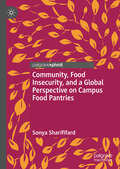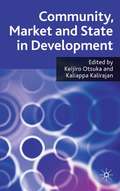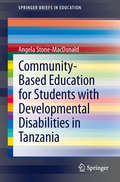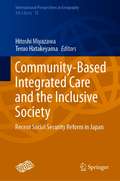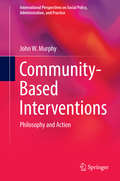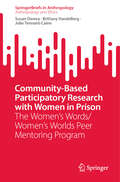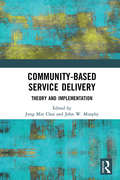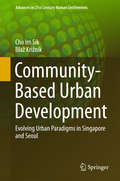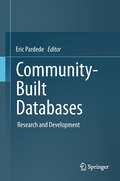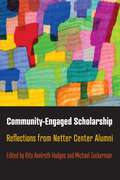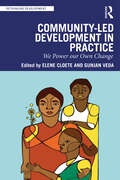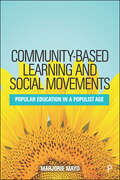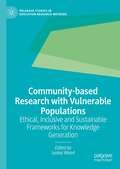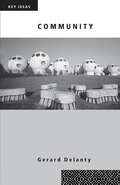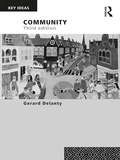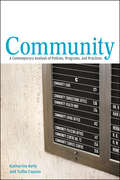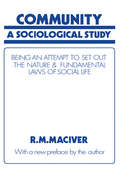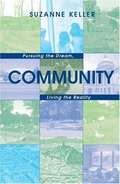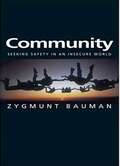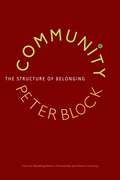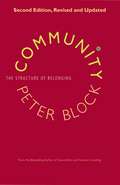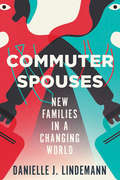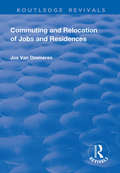- Table View
- List View
Community, Food Insecurity, and a Global Perspective on Campus Food Pantries
by Sonya SharififardThis book explores food accessibility and its relationship to food security in communities representing high populations of college and university students. Each chapter offers readers a vivid and multifaceted perspective on food practices' cultural and social complexities and the current food system. Using insights from the multidisciplinary fields of food studies, educational leadership, and human geography, this book engages the global paradoxes of food. Food is individual and community-based, and students participating in school activities and extracurriculars must often choose between affording books or food. Each chapter begins with a case study and ends with suggested resources and activities. Chapter topics include academic success, identity and belonging, groceries, food media, public health, marketing, surplus and scarcity, and social impact. The book further blends concepts and empirical accounts to address the central issues of culture, structure, and accessibility within and among the food retail environment.
Community, Hierarchy and Open Education (Routledge Library Editions: Education)
by Gary EasthopeThe book describes the English school, especially the secondary school, as a hierarchical community in which the head-teacher (principal) is an autocratic ruler. After explaining how that particular organisation of the school developed historically from the market situation faced by the English public (i.e. private) schools in the developing industrial society of the nineteenth century it provides empirical evidence demonstrating that the hierarchies of knowledge, teachers and students that developed then were still in place when the book was published in 1975. They are still present today. It also looks at the challenges to the school as a hierarchical community presented by the ideologies of deschooling, progressive education and open education. Finally, it provides an explanation of why these ideologies were never put into practice in English schools despite some pioneering exemplars. Although first published over thirty-five years ago the issues examined in it raise questions that are still central to education today: Does size of school affect the commitment of teachers to the school, their colleagues and their students? How can the teaching staff be organised in a school? Do all need to work to the same ends? What is the role of leadership from the head-teacher (principal) in this? Is it possible to have a curriculum that is open without losing rigour? What should be the relationship between using local community knowledge and the educational wish to extend students’ horizons? The result is a short, nuanced, and densely argued text that demands thought and reflection from any contemporary educator.
Community, Market and State in Development
by Keijiro Otsuka Kaliappa Kalirajan'How to combine the community, the market, and the state in the total economic system is probably the most important agenda for economists geared towards the reduction of poverty in developing economies'. - Professor Yujiro HayamiThis volume brings together leading scholars from all around the world to examine and extend Professor Hayami's development model of 'community, market and state', and to pay tribute to his invaluable contribution to economics. The authors provide new empirical analysis with a clear focus on the role of the community in economic development, and its relations with agricultural markets, industrialization and the government, using primary data from major countries in Asia and Africa. This book is indispensable reading for all interested in development economics, government and market studies and international development studies.
Community-Based Education for Students with Developmental Disabilities in Tanzania (SpringerBriefs in Education)
by Angela Stone-MacdonaldBased on a yearlong ethnographic study, this book describes the daily life and work of the Irente Rainbow School, a special education school for students with developmental disabilities in Lushoto, Tanzania. It examines the use of local context, community funds of knowledge, culturally relevant pedagogy, and community support to teach students with disabilities important life skills, independence, self-advocacy and to fight for their human rights. This book offers several lessons for different audiences; it is a primer on disability and education in a rural African town, an alternative model for non-governmental agencies to consider in designing community-based and community-engaged programs, and a story about an exceptional group of teachers, students and families who took action to provide an education and a realization of rights for children with disabilities.
Community-Based Integrated Care and the Inclusive Society: Recent Social Security Reform in Japan (International Perspectives in Geography #12)
by Hitoshi Miyazawa Teruo HatakeyamaThis book discusses the building of comprehensive community support systems, which constitutes a key issue in social security reforms in Japan. The book comprises three parts: (I) Mapping Social Security in Japan, (II) Community-Based Integrated Care Systems in Japan, and (III) A Prospect of Community-Based Inclusive Society in Japan. The chapters in this book were composed on the basis of research into community-based integrated care systems and community-based inclusive society, conducted by members of the Association of Japanese Geographers’ Study Group “Regional Issues Related to the Birthrate Decline and Population Aging.” Choosing local governments with different regional characteristics, the authors conducted empirical research to uncover the characteristics of comprehensive community support systems, building processes, and challenges in the respective local governments. Non-Japanese readers will acquire an understanding of the characteristics of social security and the trends of the reforms in Japan. To support its use as a reference book, chapters in Part I include numerous maps and figures with the themes of welfare, medical care, and health levels in Japan.
Community-Based Interventions: Philosophy and Action (International Perspectives on Social Policy, Administration, and Practice)
by John W. MurphyFor decades, community-centered social services have been promoted as an admirable ideal. Yet the concept of decentralized services delivered where people live has proved to be an elusive ideal as well, with the promise of empowerment often giving way to disinterest and apathy. Community-Based Interventions examines the reasons community programs tend to founder and proposes a realistic framework for sustained success. The book's theoretical, philosophical and political foundations begin with the importance of context, as in local knowledge and community self-definition and engagement. Innovative, often startling, approaches to planning, design and implementation begin with the recognition that communities are not "targets" or "locations" to be "fixed," but social realities whose issues require concrete answers. The variety of examples described in these chapters demonstrate the power of community interventions in providing effective services, reducing inequities and giving individuals greater control over their health, their environment and in the long run, their lives. Included in the coverage: Redefining community: the social dimensions. A new epidemiology to inform community work. The role of research in designing community interventions. The conceptual flow of a community-based project. Building autonomy through leadership from below. Relating social interventions to social justice. Attuned to the current era of health and mental health reform, Community-Based Interventions represents a major step forward in its field and makes an inspiring text for social workers, clinical social workers, public health administrators and community activists.
Community-Based Participatory Research with Women in Prison: The Women’s Words/Women’s Worlds Peer Mentoring Program (SpringerBriefs in Anthropology)
by Susan Dewey Brittany VandeBerg Julie Tennant-CaineThis innovative work tells the story of a unique partnership between a state prison administration and a team of incarcerated women, prison administrators, researchers, artists, and students known as The WoW Collective due to their joint efforts in developing a peer mentoring program called “Women’s Words/Women’s Worlds (WoW).” Using the example of WoW, the book provides a guide to doing community-based participatory research (CBPR) with women in prison that takes a collaborative—rather than the typically adversarial—approach to working together toward the goal of transformative social change. This book provides a ground-breaking example of how incarcerated women, prison administrators, researchers, and artists successfully worked together on a community-based project that led to meaningful results in the form of a peer mentoring program designed by women in prison for women in prison. Remaining closely attuned to the ethical dimensions of doing CBPR in a highly structured prison environment, this book provides inspiration to CBPR practitioners who seek to work within the criminal justice system to create real and meaningful change for the better. Co-authored by two criminologists, a senior prison administrator, and the unique collective known as WoW, this book provides both a clear step-by-step CBPR guide and a visionary approach to working with criminal justice practitioners.
Community-Based Service Delivery: Theory and Implementation
by Jung Min ChoiThis book takes up the challenge of the failure of most initiatives in community-based service delivery to address the significant philosophical shift that is necessary to create, implement, and evaluate appropriately these sorts of projects. Challenging the tendency to focus entirely on practicalities, the authors emphasize the centrality of philosophy to any successful community-based undertaking. While fully acknowledging the importance of local knowledge and the guidance of projects by local people, this volume shows that these principles are often at odds with the ‘Cartesian’ mindset that underpins much project planning, with its emphasis on objectivity in science and knowledge. Since all knowledge is mediated by human activity and embedded in language and other modes of expression, this dualist approach must be reconsidered. A thorough rethinking of traditional service delivery, which takes into account issues of data, methodology, and bias together with questions of generalizability, community, power, and communication, this book will appeal to scholars of sociology, social policy, and social work with interests in community-based service delivery.
Community-Based Urban Development: Evolving Urban Paradigms in Singapore and Seoul (Advances in 21st Century Human Settlements)
by Im Sik Cho Blaž KrižnikThe book compares different approaches to urban development in Singapore and Seoul over the past decades, by focusing on community participation in the transformation of neighbourhoods and its impact on the built environment and communal life. Singapore and Seoul are known for their rapid economic growth and urbanisation under a strong control of developmental state in the past. However, these cities are at a critical crossroads of societal transformation, where participatory and community-based urban development is gaining importance. This new approach can be seen as a result of a changing relationship between the state and civil society, where an emerging partnership between both aims to overcome the limitations of earlier urban development. The book draws attention to the possibilities and challenges that these cities face while moving towards a more inclusive and socially sustainable post-developmental urbanisation. By applying a comparative perspective to understand the evolving urban paradigms in Singapore and Seoul, this unique and timely book offers insights for scholars, professionals and students interested in contemporary Asian urbanisation and its future trajectories.
Community-Built Databases: Research and Development
by Eric PardedeWikipedia, Flickr, You Tube, Facebook, LinkedIn are all examples of large community-built databases, although with quite diverse purposes and collaboration patterns. Their usage and dissemination will further grow introducing e.g. new semantics, personalization, or interactive media. Pardede delivers the first comprehensive research reference on community-built databases. The contributions discuss various technical and social aspects of research in and development in areas like in Web science, social networks, and collaborative information systems. Pardede delivers the first comprehensive research reference on community-built databases. The contributions discuss various technical and social aspects of research in and development in areas like in Web science, social networks, and collaborative information systems.
Community-Engaged Scholarship: Reflections from Netter Center Alumni
by Rita Axelroth Hodges and Michael ZuckermanA collection of stories by Penn alumni whose lives were transformed by engaging with the West Philadelphia communityFor over thirty years, the Barbara and Edward Netter Center for Community Partnerships has served as the University of Pennsylvania’s primary vehicle for advancing civic and community engagement at Penn. The Netter Center develops and helps implement democratic, mutually transformative, place-based partnerships between Penn and its local geographic community of West Philadelphia. These partnerships advance research, teaching, learning, and service while improving the quality of life and learning in the community. One of the Netter Center’s primary objectives has been to educate Penn students to be creative, compassionate, ethical citizens who contribute significantly to improving the welfare of others—while they are students and throughout their lives and careers.Community-Engaged Scholarship is a collection of stories told by alumni of the University of Pennsylvania whose lives were profoundly shaped by engaging with the West Philadelphia community as students. Their reflections trace the linear relationship between their involvement in democratic community partnerships through Penn’s Netter Center and their current professional activities, primarily in academia, where they remain actively engaged in the struggle to build a more democratic and equitable society. The mutuality and humility that pervade these autobiographical accounts are the core of the democratic aspiration to which the Netter Center is and has always been dedicated. The stories are testimony to the Netter Center’s and founding director Ira Harkavy’s enduring influence on the next generation of community-engaged scholars and practitioners.Contributors: H. Samy Alim, Jeff Camarillo, Christina Cantrill, Tamara Dubowitz, Bernice Garnett, Rita Axelroth Hodges, John L. Jackson Jr., Jacqueline Kraemer, David Park, Jiyoung Park, Wendell Pritchett, Eric Schwartz, Margo Shea, Salamishah Tillet, Kim Van Naarden Braun, Michael Vazquez, Jason Yip, Andrew Zitcer, Michael W. Zuckerman.
Community-Led Development in Practice: We Power Our Own Change (Rethinking Development)
by Gunjan Veda Cloete, Edited by EleneIn the last decade, the international development sector has been re-examining its ways of thinking, being, and doing, and we have seen a growing consensus around the need to centre communities in development. However, there is little clarity on what such centring entails and how it can be achieved. This edited volume addresses this gap by highlighting what community-led practices look like and how they compare across different sociocultural and organisational landscapes.Bringing together the work of over 30 international authors, ranging from experienced community-led development practitioners to acclaimed scholars, the book reflects on and critically analyses grassroots initiatives, national-level organisations, and larger-scale international operations. The case studies demonstrate the similarities and differences in community-led practices according to organisational size and spread, while documenting the process of human change that these practices unleash. The volume’s overarching structure reflects the characteristics and processes of community-led development, captured via nine different dimensions: participation inclusion and voice; local resources; sustainability and exit strategies; accountability; responsiveness to context; collaboration (including working with sub-national governments); community-led monitoring and evaluation practices; and facilitation.The book will be of interest to funders, organisations and practitioners looking for non-Western, non-dominant, everyday stories of change. It will also be useful to policymakers, students, and researchers from the fields of community development and international development theory and practice.
Community-based Learning and Social Movements: Popular Education in a Populist Age
by Marjorie MayoThe rise of Far Right populism poses major challenges for communities, exacerbating divisions, hate speech and hate crime. This book shows how communities and social justice movements can effectively tackle these issues, working together to mitigate their underlying causes and more immediate manifestations. Showing that community-based learning is integral to the development of strategies to promote more hopeful rather than more hateful futures, Mayo demonstrates how, through popular education and participatory action research, communities can develop their own understandings of their problems. Using case studies that illustrate education approaches in practice, she shows how communities can engineer democratic forms of social change.
Community-based Research with Vulnerable Populations: Ethical, Inclusive and Sustainable Frameworks for Knowledge Generation (Palgrave Studies in Education Research Methods)
by Lesley WoodThis book advocates for community-based research with vulnerable populations within the field of higher education. The chapters outline how research can democratize knowledge generation to make it more accessible and socially relevant, and emphasizes the value of the lived and experiential knowledge of vulnerable and marginalized populations. Rooted in a critique of the current practices of higher education that fail to support participatory and transformative research, the research is structured at micro, macro and meso levels to ultimately emancipate colonized thinking of stakeholders about power, privilege and participation. Focusing primarily on various contexts within the Global South, the contributors argue that the time is ripe for community-based research which combines the theoretical knowledge of the academy with the local, experiential knowledge of those experiencing the consequences of social inequality to co-construct knowledge for change.
Community: 3rd Edition (Key Ideas)
by Gerard DelantyThe increasing individualism of modern Western society has been accompanied by an enduring nostalgia for the idea of community as a source of security and belonging and, in recent years, as an alternative to the state as a basis for politics.Gerard Delanty begins this stimulating introduction to the concept with an analysis of the origins of the idea of community in Western Utopian thought, and as an imagined primitive state equated with traditional societies in classical sociology and anthropology. He goes on to chart the resurgence of the idea within communitarian thought, the complications and critiques of multiculturalism, and its new manifestations within a society where new modes of communication produce both fragmentation and the possibilities of new social bonds. Contemporary community, he argues, is essentially a communication community based on new kinds of belonging. No longer bounded by place, we are able to belong to multiple communities based on religion, nationalism, ethnicity, life-styles and gender.
Community: 3rd edition (Key Ideas)
by Gerard DelantyThe increasing atomization of modern society has been accompanied by an enduring nostalgia for the idea of community as a source of security and belonging in an increasingly insecure world. Far from disappearing, community has been revived by transnationalism and by new kinds of individualism. Gerard Delanty begins this stimulating critical introduction to the concept with an analysis of the origins of the idea of community in Western utopian thought, and as a theme in classical sociology and anthropology. He goes on to chart the resurgence of the idea within communitarian thought and postmodern philosophies, the complications and critiques of multiculturalism, and new manifestations of community within a society where changing modes of communication produce both fragmentation and possibilities of new social bonds. Contemporary community, he argues, is essentially a communication community based on belonging and sharing, and can be a powerful voice of political opposition. The communities of today are less spatially bounded than those of the past, but they cannot dispense with the need for a sense of belonging. The communicative ties and cultural structures of contemporary societies have opened up numerous possibilities for belonging based on religion, nationalism, ethnicity, lifestyle and gender.
Community: A Contemporary Analysis Of Policies, Programs, And Practices
by Katharine Kelly Tullio CaputoCommunity is an elusive yet frequently invoked concept. Terms like community health, community living, community schools, community policing, community development, and community renewal have become part of the contemporary lexicon. What has led organizations, and particularly Western governments, to take such an interest in community, and why this interest now? What has caused the increasing acceptance of community as the primary vehicle through which a wide variety of government programs and services should be delivered? And what has this shift of focus meant for those living and working in communities? Using real-life case studies that include affordable housing and environmental and crime-prevention initiatives, Community is the perfect primer for understanding the theoretical and practical elements of contemporary community policies and practices, ideal for those working, or training to work, at the local level.
Community: A Sociological Study, Being an Attempt to Set Out Native & Fundamental Laws
by Robert M MacIverFirst Published in 1970. Routledge is an imprint of Taylor & Francis, an informa company.
Community: Pursuing the Dream, Living the Reality
by Suzanne KellerThis book tells the story of how a human community comes to be and how aspirations for the good life confront the dilemmas and detours of real life. Suzanne Keller combines penetrating analysis of classic ideas about community with a remarkable and unprecedented thirty-year case study of one of the first "planned unit developments" in America and the first in New Jersey. Twin Rivers, this pioneering venture, featured townhouses and shared spaces for children's play and adult work and play in a society that stresses individual over collective goals and private over public concerns. Hence the timeless questions asked over millennia: How does an aggregate of strangers create an identity of place, shared goals, viable institutions, and a spirit of mutuality and reciprocity? What obstacles stand in the way and how are these overcome? And how does design generate (or deter) community spirit?Inspired by the legacy of Plato, Rousseau, de Tocqueville, and T nnies, Keller traces the difficult birth and the rich unfolding of Twin Rivers from a former potato field into a vibrant contemporary community. Most community studies remain at a highly descriptive level. This book has both broader and deeper aims, endeavoring to develop principles of the common life as we enter the age of cyberspace. Keller reveals the community of Twin Rivers through a multidimensional social microscope, having monitored the community from the day it opened by participant observation, attitude surveys, the study of collective records, and nearly 1,000 in-depth interviews with homeowners. She offers fascinating insight into how residents maintain privacy, relate to neighbors, cope with social conflict, and develop ideas about the common good. She shows that Twin Rivers residents remain hopeful about the possibility of community despite variable success in achieving their desires. Indeed, she argues that the hard-won experience, more than the utopian ideal, is the true measure of community. Keller concludes that, despite the homogenizing effects of mass communication and globalization, local communities will continue to proliferate in the foreseeable future--due to changing lifestyles and the continuing quest for roots. This important and engaging book will be appreciated by social scientists, architects, physical planners, developers and lenders, and community leaders as well as by the general reader interested in creating a bridge between individualism and community.
Community: Seeking Safety in an Insecure World (Themes for the 21st Century Series #3)
by Zygmunt Bauman'Community' is one of those words that feels good: it is good 'to have a community', 'to be in a community'. And 'community' feels good because of the meanings which the word conveys, all of them promising pleasures, and more often than not the kind of pleasures which we would like to experience but seem to miss. <p><p> 'Community' conveys the image of a warm and comfortable place, like a fireplace at which we warm our hands on a frosty day. Out there, in the street, all sorts of dangers lie in ambush; in here, in the community, we can relax and feel safe. 'Community' stands for the kind of world which we long to inhabit but which is not, regrettably, available to us. Today 'community' is another name for paradise lost - but for a paradise which we still hope to find, as we feverishly search for the roads that may lead us there. <p><p> But there is a price to be paid for the privilege of being in a community. Community promises security but seems to deprive us of freedom, of the right to be ourselves. Security and freedom are two equally precious and coveted values which could be balanced to some degree, but hardly ever fully reconciled. The tension between security and freedom, and between community and individuality, is unlikely ever to be resolved. We cannot escape the dilemma but we can take stock of the opportunities and the dangers, and at least try to avoid repeating past errors. <p><p> In this important new book, Zygmunt Bauman takes stock of these opportunities and dangers and, in his distinctive and brilliant fashion, offers a much-needed reappraisal of a concept that has become central to current debates about the nature and future of our societies.
Community: The Structure of Belonging
by Peter BlockMost of our communities are fragmented and at odds within themselves. Businesses, social services, education, and health care each live within their own worlds. The same is true of individual citizens, who long for connection but end up marginalized, their gifts overlooked, their potential contributions lost. What keeps this from changing is that we are trapped in an old and tired conversation about who we are. If this narrative does not shift, we will never truly create a common future and work toward it together. What Peter Block provides in this inspiring new book is an exploration of the exact way community can emerge from fragmentation. How is community built? How does the transformation occur? What fundamental shifts are involved? What can individuals and formal leaders do to create a place they want to inhabit? We know what healthy communities look like—there are many success stories out there. The challenge is how to create one in our own place. Block helps us see how we can change the existing context of community from one of deficiencies, interests, and entitlement to one of possibility, generosity, and gifts. Questions are more important than answers in this effort, which means leadership is not a matter of style or vision but is about getting the right people together in the right way: convening is a more critical skill than commanding. As he explores the nature of community and the dynamics of transformation, Block outlines six kinds of conversation that will create communal accountability and commitment and describes how we can design physical spaces and structures that will themselves foster a sense of belonging. In Community, Peter Block explores a way of thinking about our places that creates an opening for authentic communities to exist and details what each of us can do to make that happen.
Community: The Structure of Belonging
by Peter BlockAs a response to the increasing violence in our culture, the widening ideological divides, and the growing gap in economic well-being, there is greater awareness that a deeper sense of community is desperately needed. But even as we acknowledge the need to build community, the dominant on-the-ground practices about how to engage people, civically and organizationally, remain essentially unchanged. We still believe community is built with better messaging, more persuasion, and social events for people to get to know each other better. All of which is naïve. In this new edition, Block draws on a decade of putting these ideas into practice to emphasize what has worked and extract those thoughts that were nice but had no durability. He explores how technology, instead of bringing us together, has driven us into more isolation. New examples show that community building can be a more powerful way to address social problems than more traditional policies and programs. And encouragingly, Block insists this is really simple, once we decide it is essential. He offers a way of thinking that creates an opening for authentic communities to exist and details what each of us can do to make that happen.
Commuter Spouses: New Families in a Changing World
by Danielle LindemannWhat can we learn from looking at married partners who live apart? In Commuter Spouses, Danielle Lindemann explores how couples cope when they live apart to meet the demands of their dual professional careers. Based on the personal stories of almost one-hundred commuter spouses, Lindemann shows how these atypical relationships embody (and sometimes disrupt!) gendered constructions of marriage in the United States. These narratives of couples who physically separate to maintain their professional lives reveal the ways in which traditional dynamics within a marriage are highlighted even as they are turned on their heads. Commuter Spouses follows the journeys of these couples as they adapt to change and shed light on the durability of some cultural ideals, all while working to maintain intimacy in a non-normative relationship.Lindemann suggests that everything we know about marriage, and relationships in general, promotes the idea that couples are focusing more and more on their individual and personal betterment and less on their marriage. Commuter spouses, she argues, might be expected to exemplify in an extreme manner that kind of self-prioritization. Yet, as this book details, commuter spouses actually maintain a strong commitment to their marriage. These partners illustrate the stickiness of traditional marriage ideals while simultaneously subverting expectations.
Commuting and Relocation of Jobs and Residences
by Jos Van OmmerenThis title was first published in 2000: An analysis of commuting behaviour from an integrated labour and housing market perspective. A theoretical search model is proposed and analyzed with an emphasis on two-owner households. The book provides insights into the relationship between job and residential moving and commuting behaviour.
Como Ser Um Minimalista Digital: Simplifique Sua Vida e Elimine a Desordem Usando a Tecnologia
by Dan GainesVocê está procurando simplificar sua vida? Você está procurando reduzir ou eliminar a desordem? Você está procurando economizar dinheiro? Se você respondeu sim a alguma dessas perguntas, este guia é para você! Aprenda as etapas essenciais de como usar o minimalismo digital para simplificar sua vida. Não apenas isso, mas você aprenderá como: - Economizar dinheiro, eliminando gastos desnecessários - Economizar tempo organizando sua vida - Poupar aborrecimentos eliminando a desordem -Seja mais feliz e tenha uma mente tranquila Isso e muito mais quando você clica no botão "Comprar agora" para usar o minimalismo digital para criar uma vida melhor!
